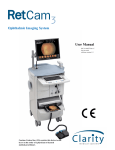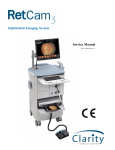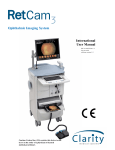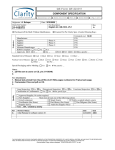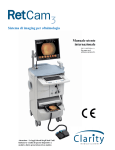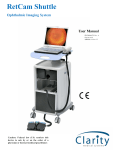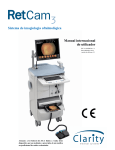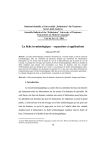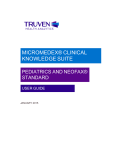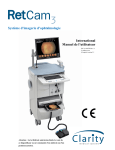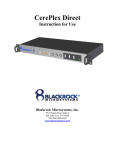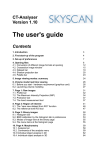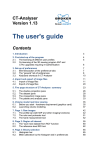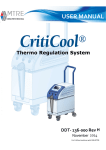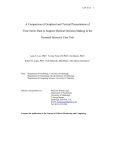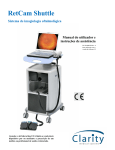Download Ophthalmic Imaging System User Manual
Transcript
Ophthalmic Imaging System User Manual PN 21-100277 Rev. C For use with software version 5.1 Caution: Federal law (US) restricts this device to sale by or on the order of a physician or licensed medical practitioner. 2 Copyright © 2008 Clarity Medical Systems, Inc. All rights reserved. MediMark® Europe S.A.R.L. 11 rue Emile Zola 38100 GRENOBLE France Tel: +33 (0)4 76 86 43 22 Fax: +33 (0)4 76 17 19 82 e-mail: [email protected] RetCam3 User Manual PN 21-100277 Rev. C 3 Contents 1 Introduction.................................................................................... 7 • Indications for Use ..................................................................................................... 7 • Warnings and Cautions................................................................................... 7 • Main Hardware Components ..................................................................................... 9 • Electrical Safety Information ......................................................................... 10 • Important User Safety Notices ...................................................................... 13 • Labels and Symbols...................................................................................... 14 • Product Label .......................................................................................................... 18 2 Using the RetCam 3 .................................................................... 19 • Turning the System ON (from Stand-by Mode) ............................................. 19 • Installing Lens Pieces ................................................................................... 21 • Turning the System OFF (Stand-by Ready) .................................................. 21 • Using Hard Shutdown ................................................................................... 22 • Turning OFF the Main Power........................................................................ 23 • Managing Patient Records............................................................................ 23 • Add a New Patient Record ...................................................................................... 24 • Editing a Patient Record .......................................................................................... 24 • Finding Existing Patient Records............................................................................. 25 • Performing Exams......................................................................................... 26 • • • • Capturing Still Images.............................................................................................. 28 Capturing Video ....................................................................................................... 29 Video Playback ........................................................................................................ 30 Deleting a Video ...................................................................................................... 30 • Using Helpful Features.................................................................................. 30 • Shortcut Keys .......................................................................................................... 30 • Still Images From Video........................................................................................... 30 • Changing Image Capture Options During an Exam ................................................ 32 • Adding Exam Notes ...................................................................................... 33 3 Review and Compare Images ..................................................... 35 • Review Screen .............................................................................................. 35 • Compare Mode ............................................................................................. 38 • Image Adjustment ......................................................................................... 39 • Adjust Image Display Parameters ........................................................................... 40 • Annotating Images................................................................................................... 41 4 Import and Export Images ........................................................... 43 • Backing Up Images ....................................................................................... 43 • Exporting Images .......................................................................................... 43 • • • • • • Select Images for Export ......................................................................................... 44 Select Export Options .............................................................................................. 45 Select the File Format ............................................................................................. 45 Export Image Formats ............................................................................................. 46 Export Data Formats................................................................................................ 46 Complete Export ...................................................................................................... 47 • Importing Images .......................................................................................... 47 RetCam3 User Manual PN 21-100277 Rev. C 4 5 Printing Images............................................................................ 51 • Printing Images and Reports......................................................................... 51 • Recommended Supplies ............................................................................... 52 6 Fluorescein Angiography............................................................. 53 • Theory of Operation ...................................................................................... 53 • Using Fluorescein Angiography (FA) Mode .................................................. 53 • Configuring the FA Timer......................................................................................... 55 7 Maintenance and Support ........................................................... 57 • Recommended Maintenance Schedule ........................................................ 57 • Cleaning Procedures .................................................................................... 57 • Cleaning the Lens Piece.......................................................................................... 57 • Cleaning the Rest of the System ............................................................................. 59 • Disposal of Materials ............................................................................................... 59 • Fuse Replacement ........................................................................................ 68 • Replace Illumination Lamp........................................................................... 70 • Key Validation ............................................................................................... 72 • Technical Support ......................................................................................... 73 • Technical Support Contact Information.................................................................... 73 • Service Information ....................................................................................... 74 8 User Preferences......................................................................... 75 • • • • Institution ................................................................................................................. 77 New Exam ............................................................................................................... 77 Printers .................................................................................................................... 78 Windows Configuration............................................................................................ 78 9 Technical Specifications............................................................... 79 • Hardware ...................................................................................................... 79 • Physical ................................................................................................................... 79 • Electrical .................................................................................................................. 79 • Environmental Conditions........................................................................................ 79 10 License Agreements.................................................................... 81 • CMS Software Restricted Rights................................................................... 81 • RetCam3 Software End User License Agreement........................................ 81 Index............................................................................................83 RetCam3 User Manual PN 21-100277 Rev. C 5 List of Figures Figure 1 RetCam3 Ophthalmic Imaging System front view*................................................... 8 Figure 2 RetCam3 Ophthalmic Imaging System rear view ..................................................... 9 Figure 3 Handpiece and Lens piece ..................................................................................... 10 Figure 4 Control panel .......................................................................................................... 20 Figure 5 Installing a lens piece on the handpiece................................................................. 20 Figure 6 Handpiece connections .......................................................................................... 21 Figure 7 Shutdown button..................................................................................................... 22 Figure 8 Footswitch pocket ................................................................................................... 22 Figure 9 Start screen ............................................................................................................ 23 Figure 10 Add new patient screen .......................................................................................... 24 Figure 11 Edit patient record screen....................................................................................... 25 Figure 12 Search buttons ....................................................................................................... 25 Figure 13 Patient search options ............................................................................................ 25 Figure 14 Patients and Exams Screen (Patient Directory) ..................................................... 26 Figure 15 Patients and Exams screen navigation buttons...................................................... 26 Figure 16 New Exam configuration screen ............................................................................. 27 Figure 17 Show Thumbnails button ........................................................................................ 27 Figure 18 Still image screen ................................................................................................... 28 Figure 19 Onscreen capture controls ..................................................................................... 28 Figure 20 Progress bar ........................................................................................................... 29 Figure 21 Video and image capture controls .......................................................................... 29 Figure 22 Video thumbnails .................................................................................................... 31 Figure 23 Video scrollbar control ............................................................................................ 31 Figure 24 Select options for image capture ............................................................................ 32 Figure 25 Enable mouse-over ................................................................................................ 33 Figure 26 Exam Notes dialog ................................................................................................. 33 Figure 27 Exam Review screen .............................................................................................. 35 Figure 28 Compare [Images] screen ...................................................................................... 38 Figure 29 Edit Image button ................................................................................................... 39 Figure 30 Select patients and exams for export ..................................................................... 44 Figure 31 Export dialog........................................................................................................... 44 Figure 32 Export destination options ...................................................................................... 45 Figure 33 Select file format ..................................................................................................... 45 Figure 34 Select image and data format................................................................................. 46 Figure 35 Export progress dialog............................................................................................ 47 Figure 36 Start screen ............................................................................................................ 48 Figure 37 Import Folder dialog................................................................................................ 48 Figure 38 Import successful.................................................................................................... 50 Figure 39 Print dialog.............................................................................................................. 51 Figure 40 Front panel of FA .................................................................................................... 53 RetCam3 User Manual PN 21-100277 Rev. C 6 Figure 41 Barrier filter installation ........................................................................................... 54 Figure 42 FA timer controls .................................................................................................... 55 Figure 43 Inverted lens piece showing permissible depth of immersion................................. 58 Figure 44 Power Entry Module ............................................................................................... 68 Figure 45 Opening the fuse holder cover ............................................................................... 68 Figure 46 Removing the fuse holder....................................................................................... 69 Figure 47 Fuses removed ....................................................................................................... 69 Figure 48 Fuse holder re-inserted .......................................................................................... 70 Figure 49 Front panel showing the lamp assembly drawer .................................................... 71 Figure 50 Removing the illumination lamp.............................................................................. 71 Figure 51 Key Validation dialog .............................................................................................. 73 Figure 52 Access User Preferences ....................................................................................... 75 Figure 53 About Clarity software ............................................................................................ 75 Figure 54 User Preferences screen ........................................................................................ 76 Figure 55 User Preferences: Institution .................................................................................. 77 Figure 56 User Preferences: New Exam ................................................................................ 77 Figure 57 User Preferences: Printers ..................................................................................... 78 Figure 58 User Preferences: Windows Configuration............................................................. 78 RetCam3 User Manual PN 21-100277 Rev. C Introduction 7 1 Introduction The RetCam3 Ophthalmic Imaging System (system) is designed to allow the quick and easy capture of wide field, high resolution, fully digital images and videos of the eye. Indications for Use For general ophthalmic imaging, including retinal, corneal, and external. Warnings and Cautions CAUTION: Federal law (US) restricts this device to sale by or on the order of a physician or licensed medical practitioner. WARNING: Prior to using the system, read all user safety information. WARNING: Before using this equipment to acquire images from patient eyes, users must be trained in proper clinical technique by personnel authorized by Clarity. WARNING: The RetCam system is designed and tested as a system. Omission or substitution of RetCam components may adversely affect system performance and is strongly not recommended. WARNING: Unauthorized modifications or additions to the RetCam system (including hardware and software, etc.) could adversely affect system function and will void the warranty. WARNING: Carefully inspect and clean the lens piece before each use. DO NOT use if the lens piece has nicks, breaks, scratches, or rough surfaces that may damage the eye. WARNING: To mitigate the potential for excess light exposure, always start at the lowest light intensity level and increase if necessary. Use only the shortest amount of exposure time necessary; no greater than 5 minutes. WARNING: Use care when contacting the eye; i.e., use the least amount of pressure and/or movement necessary. WARNING: A risk/benefit ratio must be assessed before confirming a patient for RetCam imaging if they are: photosensitive, concomitantly exposed to photosensitizing agents, or aphakic. WARNING: To avoid the risk of electric shock, the equipment must be connected to a supply mains with protective earth. WARNING: To mitigate the potential for excess light exposure, the user should avoid looking directly at the illuminated light source. RetCam3 User Manual PN 21-100277 Rev. C 8 Introduction Display (contains 4 USB ports) Transport Handle Handpiece with Interchangeable Lens Piece Input Shelf (extended) Holster Keyboard & Mouse Control Panel DVD writer (inside drawer) USB port Handpiece Cable with Connectors FA Intensity Control Cord Wrap Post (both sides) FA Light Connector FA Light Switch Storage Drawers Printer on Extended Shelf Lockable Front Casters Footswitch Storage Pocket Footswitch Figure 1 RetCam3 Ophthalmic Imaging System front view* *Shown with optional FA (Fluorescein Angiography) feature RetCam3 User Manual PN 21-100277 Rev. C Introduction 9 Ethernet Port Product Label Main Power Switch and Power Cord Connection Figure 2 RetCam3 Ophthalmic Imaging System rear view Main Hardware Components • Display: A flat panel display is standard with the system. • Control Panel: A membrane control panel turns the system on with one button, and has controls for illumination intensity, camera focus and snap (capture an image or start/stop video recording). • Handpiece: Contains the camera. Lightweight and easy to position, it has a long cable for easy reach. Use with changeable lens pieces. RetCam3 User Manual PN 21-100277 Rev. C 10 Introduction • Chassis: Contains the control systems and connections. • Footswitch: Provides optional means to control illumination intensity, camera focus and snap. • Storage Drawers: All units have two storage drawers for lens pieces, tools and supplies. • Fluorescein Angiography Source (optional): An optional blue exciter light source is available for FA digital photography. It comes complete with a yellow barrier filter for the handpiece. You can adjust illumination intensity only through the FA intensity control. • Printer: Color images and reports can be printed. Handpiece Lens piece Figure 3 Handpiece and Lens piece Lens Model D1300 B1200 E800 C300 PL200 Application Premature Infant Standard Baby High Contrast Children’s & Adults High Magnification Portrait Lens Common Field of View 130 Degrees 120 Degrees 80 Degrees 30 Degrees N/A Electrical Safety Information The system has been designed, inspected and tested to comply with the safety requirements of IEC60601-1 with respect to fire, shock and mechanical hazards only if used as intended. Class I Type BF Electrical Equipment Rated for Continuous Operation RetCam3 User Manual PN 21-100277 Rev. C Introduction 11 Electromagnetic Emissions Compliance Level: Group 1, Class A Test Type Compliance Level Conducted Emissions CISPR 11/ EN 55011 Class A Radiated Emissions CISPR 11/ EN 55011 Class A Harmonic emissions IEC 61000-3-2 Complies Voltage fluctuations/flicker emissions IEC 61000-3-3 Complies FCC Part 15B Complies RetCam3 User Manual Notes The RetCam system uses RF energy for its internal function. Nearby electronic equipment may be affected. PN 21-100277 Rev. C 12 Introduction Electromagnetic Immunity Test Type Electrostatic Discharge (ESD) EN 61000-4-2 IEC 60601-1-2 test and compliance level ±6 kV contact ±8 kV air Electromagnetic Environment Guidance Floors should be wood, concrete or ceramic tile. If floors are covered with synthetic material, the relative humidity should be at least 30%. ±2 kV for power supply lines Mains power quality should be that of a typical commercial or hospital environment. AC Power electronic disturbances (transients) may cause the system's display to scroll continuously. If this occurs, imaging should not processed until the disturbance has ceased. Surge Line to Line (AC Power) (I/O Lines) EN 61000-4-5 ±1 kV line(s) to line(s) Mains power quality should be that of a typical commercial or hospital environment. >95% dip in Ut 0.5 cycle 60% dip in Ut 5 cycles 30% dip in Ut 25 cycles >95% dip in Ut 5 seconds If the user of the RetCam system requires continued operation during power mains interruptions, it is recommended that the RetCam system be powered from an uninterruptible power supply or a battery. Power Frequency (50/60 Hz) magnetic field EN 61000-4-8 3 A/m Power frequency magnetic fields should be at levels characteristic of a typical location in a typical commercial or hospital environment. Radiated Immunity EN 61000-4-3 80MHz-2.5GHz 3V/m 80%@1kHz Portable and mobile RF communications equipment should be used no closer to any part of the RetCam system, including cables, than the recommended separation distance calculated from the equation applicable to the frequency of the transmitter. Electrical Fast Transients (AC Power) (I/O Lines) EN 61000-4-4 Voltage dips and interruptions EN 61000-4-11 ±2 kV line(s) to earth 0.15-80MHz 3 Vrms 80%@1kHz AC Mains Recommended separation distance d = 3.5 / E1 Conducted Immunity EN 61000-4-6 P 80 MHz to 800 MHz d = 7 / E1 P 800 MHz to 2.5 GHz where P is the maximum output power rating of the transmitter in watts (W) according to the transmitter manufacturer and d is the recommended separation distance in meters (m). E1 is 3 V/m. Conducted Immunity: d= (3.5/ V1) P where V1 is 3 Vrms. Field strength from fixed RF transmitters, as determined by an electromagnetic site survey, should be less than the compliance level in each frequency range. Interference may occur in the vicinity of equipment marked with the following symbol. RetCam3 User Manual PN 21-100277 Rev. C Introduction 13 WARNING: Interference may occur in the vicinity of equipment marked with the following symbol. This equipment/system may cause radio interference or may disrupt the operation of nearby equipment. It may be necessary to take mitigation measures such as: • Reorient or relocate the receiving device • Increase the separation between the equipment • Connect the equipment into an outlet on a circuit different from that to which the other device(s) are connected. • Consult the manufacturer or field service technician for help. An error message may be displayed, which then may require a system reset. To perform a system reset, press the system power switch on the control panel for ~6 seconds until the system powers down, then press the switch again to power the system back on. WARNING: This equipment may cause radio interference or may disrupt the operation of nearby equipment. It may be necessary to take mitigation measures, such as reorienting or relocating the system or shielding the location. WARNING: To avoid the risk of electric shock, this equipment must be connected to a supply mains with protective earth. WARNING: For continued protection against risk of fire, replace only with same type and rating fuse. Important User Safety Notices 1. Never contact the front of the lens piece with hard or sharp objects. This could damage the precision optics and sealing. 2. DO NOT AUTOCLAVE any part of the device. 3. Appropriately power down and unplug the unit and allow the light source bulb to cool before replacing it. 4. Always return the handpiece to the holster when not imaging. You can drape the handpiece cable over the cord wrap post, but do not wrap it tightly or damage to the fiber optic may result. 5. Do not block access to the holster. 6. The system is not intended to be transported outdoors. 7. Newly acquired data may be lost if power is interrupted during live imaging. + RetCam3 User Manual Note: backup battery power is available for at least 15 minutes after interrupt. PN 21-100277 Rev. C 14 Introduction 8. The system comes protected from viruses, worms, and spyware with Microsoft’s anti-malware. Please refer to your warranty prior to adding any additional software or contact Clarity Service. Labels and Symbols System Power Switch Focus Focus Controls Lamp Illumination Intensity Controls SNAP (capture) switch Read instructions Caution: Do not look directly into light source Caution: Electrical hazard High voltage in the FA unit Chassis ground Protective earth (ground) RetCam3 User Manual PN 21-100277 Rev. C Introduction 15 Alternating current (AC) System contains 2 fuses of indicated type. Do not use any other type. Backup battery Computer network Non-ionizing radiation FA = Fluorescein Angiography FA Intensity, increase clockwise FA light OFF FA light ON Light source (fiber optic) connector Handpiece connector USB connector RetCam3 User Manual PN 21-100277 Rev. C 16 Introduction Read accompanying user documentation Fragile contents This side of carton up Temperature limits Authorized representative in the EU Type BF equipment (applied part is handpiece) To prevent damage to lens piece, carefully store handpiece in holster when not in use. Clean lens piece after use Separate collection of waste at end-of-life as required by European directives. Contact Clarity for equipment disposal instructions. European conformity North American compliance certification Serial number RetCam3 User Manual PN 21-100277 Rev. C Introduction 17 Date of Manufacture Keep away from the rain RetCam3 User Manual PN 21-100277 Rev. C 18 Introduction Product Label RetCam3 User Manual PN 21-100277 Rev. C Using the RetCam 3 19 2 Using the RetCam 3 This chapter explains how to use the RetCam 3 system, after it is properly installed at your site. The activities described include: • Turning the System ON (from Stand-by Mode) on page 19 • Turning the System OFF (Stand-by Ready) on page 21 • Using Hard Shutdown on page 22 • Turning OFF the Main Power on page 23 • Managing Patient Records on page 23 • Performing Exams on page 26 • Using Helpful Features on page 30 • Adding Exam Notes on page 33 Turning the System ON (from Stand-by Mode) + New systems are installed by Clarity trained personnel. The installation includes installing main power, attaching the handpiece, and adjusting the monitor. Upon request, full installation instructions are available from the Clarity Service Department. The instructions in this chapter are for using an installed system, which has the main power, printer, and monitor turned ON, the monitor height adjusted, and software installed and configured for the site. + Note: After software is installed, the system requires an Authorization key to initiate the system. The key is available through Clarity MSI service. CAUTION: Never block any RetCam 3 System vents. CAUTION: Never block access to the handpiece holster. To turn the system ON from the Stand-by mode: 1. Carefully pull out the input shelf until it is fully extended. 2. Depress the System Power (Stand-by) button (located on the Control Panel) to turn ON system power. The System Power (Stand-by) indicator light (solid green) should be illuminated. The software should initialize. RetCam3 User Manual PN 21-100277 Rev. C 20 Using the RetCam 3 The membrane control panel is located on the lower front part of the keyboard tray. It provides controls and indicators of system status. System Power indicator (green) System power Stand-by button AC/DC indicator (green) Relative intensity indicator Focus Focus Controls Intensity Controls SNAP (capture) button Illumination ON indicator (amber) Lamp Illumination Figure 4 Control panel 3. Attach the desired lens piece to the Handpiece, as shown in Figure 5 and Installing Lens Pieces on page 21. Align lens piece to fit over pins alignment pins on handpiece Carefully tighten clockwise until it clicks in place. Do not overtorque. Figure 5 Installing a lens piece on the handpiece RetCam3 User Manual PN 21-100277 Rev. C Using the RetCam 3 21 Installing Lens Pieces A. Fit the lens piece on the handpiece, aligning the 3 radial pins on the front of the handpiece with the spaces between the tabs of the spring ring on the lens piece. B. Twist the lens piece clockwise (as shown in Figure 5) until you hear a click, indicating that the lens piece is locked in place. 4. Verify that the handpiece is connected to the system as shown in Figure 6. Figure 6 Handpiece connections Always return the handpiece to the holster when it is not in use. You can drape the handpiece cable over the cord wrap post, but do not wrap it tightly or damage to the fiber optics may result. WARNING: Carefully inspect and clean the lens piece before each use. DO NOT use if the lens piece has nicks, breaks, scratches, or rough surfaces that may damage the eye. 5. PRINTER. Extend the printer shelf fully and verify that sufficient paper is installed in the printer. The shelf can be pushed back in. 6. When the software is ready, you will see the message “Not Displaying Patients.” 7. For FA operation (if available) see Chapter 6, Fluorescein Angiography for instructions. 8. If the illumination lamp is OFF, press the illumination lamp button located on the right side on the Control Panel to turn illumination ON. The amber indicator light is illuminated when the lamp is ON. Turning the System OFF (Stand-by Ready) + RetCam3 User Manual Note: We strongly suggest that you backup and store your data prior to turning OFF the system. See Exporting Images on page 43 for details. PN 21-100277 Rev. C 22 Using the RetCam 3 1. To turn OFF the system (leaving the Stand-by Ready) hover over the red Shutdown button at the bottom of the Patients and Exams screen. Shutdown button Figure 7 Shutdown button The shutdown options screen appears. Select Shutdown Computer. 2. If the system stops responding, wait at least one minute because it may be busy. If the system does not respond after one minute, depress the System Power button (on the Control Panel) once. 3. All Control Panel indicators except for the green AC/DC indicator will turn off. 4. If FA is available, verify that the FA light switch is OFF. 5. Remove the lens from the handpiece. Carefully inspect and clean the lens piece. Store the lens in the lens box. 6. Return the handpiece to the holster. 7. Return the footswitch to the footswitch pocket (See Figure 8). Footswitch placed horizontally in footswitch storage pocket. Place footswitch cord on top of footswitch. Figure 8 Footswitch pocket + Note: To re-start the system, see Turning the System ON (from Stand-by Mode) on page 19. Using Hard Shutdown WARNING: Do not use the hard shutdown method unless necessary because data corruption can occur. RetCam3 User Manual PN 21-100277 Rev. C Using the RetCam 3 23 In the event that hard shutdown is required, continuously press the System Power button on the control panel for at least 6 seconds to force the system, including the backup battery, to shut down. Turning OFF the Main Power Flip the main power switch (located on the rear of the system) to OFF. All Control Panel indicators will be OFF except the AC/DC indicator. The AC/DC indicator will flash green while the backup battery continues to supply power (at least 15 minutes). Managing Patient Records This section describes how to add a new patient and locate the records for an existing patient. The software is ready to use when you see the start screen shown in Figure 9. Add a new patient Import data from CD, USB, network, etc. Find existing patients Figure 9 Start screen RetCam3 User Manual PN 21-100277 Rev. C 24 Using the RetCam 3 Add a New Patient Record To create a new patient record, the following information is required: • First Name • Last Name • Date of Birth • Patient ID Patient information is repeated in several of the screens. The patient name and Patient ID are always shown in the upper left corner of every screen. Click OK to proceed. Enter information manually or use menus, where available. Figure 10 Add new patient screen Editing a Patient Record Highlight the patient’s record from the Patients and Exams screen. Select Edit. You can edit the following information: • First Name • Last Name • Gender (Male, Female, Other, or Unknown) • Date of Birth • Weight (in grams) + RetCam3 User Manual Note: Any fields on the Edit Patient Screen are editable. PN 21-100277 Rev. C Using the RetCam 3 25 Figure 11 Edit patient record screen Finding Existing Patient Records You can search the directory to locate specific patient records. Figure 12 Search buttons From the Start screen, click the click the plus sign icon to display the entire patient directory or to locate patient records using one or more of the search features (see Figure 13). Figure 13 Patient search options Click Clear to clear all search fields. Search Results When you click the to display the entire patient directory, the results are displayed as shown in Figure 14. RetCam3 User Manual PN 21-100277 Rev. C 26 Using the RetCam 3 Figure 14 Patients and Exams Screen (Patient Directory) From the Patients and Exams Screen, you can use the buttons shown in Figure 15 to sort the results. Figure 15 Patients and Exams screen navigation buttons Performing Exams You can use the RetCam 3 to capture still images or video after selecting a patient. Click the green arrow on the right side of a patient name, or select the New Exam button. To start an exam, you can select a Preset Configuration, which can be easily edited, or Manual Configuration. RetCam3 User Manual PN 21-100277 Rev. C Using the RetCam 3 27 Figure 16 New Exam configuration screen The following Information can be defined in the Preset or Manual Configuration: Image Type Lens Eye Retina 300 Right (OD) Fluorescein Angiography 800 Left (OS) Anterior Segment 1200 Unspecified Unspecified 1300 Unspecified Once the new exam is configured, select the green arrow to the right to enter the New Exam screen. Select Show Thumbnails at the bottom of the Exam screen to maximize the available features. Figure 17 Show Thumbnails button 0 RetCam3 User Manual The Show Thumbnails button toggles between Show Thumbnails and Hide Thumbnails. PN 21-100277 Rev. C 28 Using the RetCam 3 Capturing Still Images Figure 18 Still image screen The recommended procedure is to capture video of the entire exam, and grab still images from the video then delete the video prior to exiting still image session after the exam is finished. You can take still images from the New Exam screen using the following: Keyboard and Mouse Some utility buttons are displayed on the monitor; use the mouse to select them. Click to save still images Click to use footswitch for stills capture Figure 19 Onscreen capture controls Use the “S” key to SNAP images. Footswitch Select Save Snapshot from the monitor display (see Figure 21 on page 28). Then use the footswitch SNAP button to SNAP images. RetCam3 User Manual PN 21-100277 Rev. C Using the RetCam 3 29 Control Panel Press the SNAP button. + Note: Saving video can take significant time and consumes a great deal of disc space. To maintain optimal system performance, select the images of interest from the video then delete the video prior to exiting Image Capture. + Note: The storage capacity of the system hard drive is a maximum of approximately 250,000 still images. Saving a combination of videos and stills will affect the total number of each that can be saved. Saving images with annotations reduces the total number of images that can be saved. + Note: If the Control Panel (or keyboard) controls do not respond, check that the Footswitch Controls are not activated. Capturing Video Up to 2 minutes of Video capture is available per session. A progress bar is enabled each time video is started to let you know the percentage of time used. Figure 20 Progress bar Video is captured at full resolution, 30 frames per second. Figure 21 Video and image capture controls The following controls are available on screen: • Record Video—Starts recording video; to stop recording video, click Stop Recording or Pause Recording. • Freeze Live—Freeze an image during image capture. • Switch to FA—Change the image type to Fluorescein Angiography. See Chapter 6, Fluorescein Angiography. • Start Timer—Start a timer to record the time elapsed during the exam. • Save Still—Saves a still image to the hard drive • Footswitch Operation options: • Use the SNAP button to pause and continue video recording. + RetCam3 User Manual Note: The storage capacity of the system hard drive is a maximum of 140 minutes of total video (for example, 70 videos of two minutes duration each, PN 21-100277 Rev. C 30 Using the RetCam 3 or 280 videos of 30 seconds each). Saving a combination of videos and stills will affect the total number of each that can be saved. Saving images with annotations reduces the total number of images that can be saved. Video Playback When you stop live recording, the playback buttons are enabled. Reverse, pause, and play Fast forward Go to the beginning of the recorded video Go back one video Advance one video Go to the end of the recorded video Control the rate of playback or search. 0 Tip: Using the left and right arrow keys on the keyboard will also move the video back or forward one frame at a time. Deleting a Video To delete a video, in the thumbnail view, click the delete icon (red “x”) at the bottom of the frame. This marks the video for deletion when you exit the exam. The delete icon toggles, that is, clicking it again before exiting the exam means the video is no longer marked for deletion. + Note: Images and video can be selected for deletion only during the imaging session. Once the session has been exited, the images will be saved for that session. Using Helpful Features The RetCam 3 software includes some useful features to streamline your work. Shortcut Keys An underlined letter indicates a quick key. To use a quick key, press ALT and the letter key simultaneously. + Note: Do not use Windows shortcut keys, for example Copy (Ctrl+C), Paste (Ctrl+V), Undo (Ctrl+Z), and others. Still Images From Video During video replay, you can identify and save still images from the exam. There are three ways to locate and save a still image. RetCam3 User Manual PN 21-100277 Rev. C Using the RetCam 3 31 1. Scroll through the thumbnails, using the arrows at the right and left ends of the strip at the bottom of the screen. Figure 22 Video thumbnails • Use the arrow at the right to scroll forward through the video and the arrow at the left to scroll back. • Stop when the image you want to save is highlighted. • With the image highlighted, click Save Still (or press ‘S’ on the keyboard or press the Snap button on the footswitch). 2. Use the scrollbar at the top of the video controls to scroll through the video, and find a frame. Figure 23 Video scrollbar control • Move the slider to the right or left to scroll forward or back through the video. • Stop the slider when you see an image you want to save. • Click Save Still (or press ‘S’ on the keyboard or press the Snap button on the footswitch). 3. Use the playback controls at the top of the screen to locate a still image: • Start playback by clicking Play • Click Pause or Reverse . when you see an image you want to save. • Click Save Still (or press ‘S’ on the keyboard or press the Snap button on the footswitch). RetCam3 User Manual PN 21-100277 Rev. C 32 Using the RetCam 3 Changing Image Capture Options During an Exam Before you start imaging, verify that the options displayed for eye, image type and lens piece are correct. If necessary, you can edit options from the image capture screen. Figure 24 Select options for image capture Changing Right Eye (OD) / Left Eye (OS) To image the other eye in the same session, expand the Eye menu and select the other eye (Right Eye (OD) or Left Eye (OS)). The Eye selection is saved with the image. + Note: When using this option, be careful that you select the correct eye before you save the image. This is especially important when both eyes are captured in one video clip, and you save still images from the video. Make sure you select the correct eye before you save each still image from the video. + Note: Images and video can be selected for deletion only during the imaging session. Once the session has been exited, the images will be saved for that session. Changing Image Type Expand the Image Type menu to select Retina, Anterior Segment, or Other during an imaging session. All selections record the images in color. The Image type selection is saved with the image. Changing Lens You can also select a different lens piece during imaging. Expand the Lens menu to select 1300 (Premature Infant), 1200 (Standard Baby), 800 (Posterior), 300 (High Mag), or Unspecified. The lens piece selection is saved with the image. WARNING: System power from a fully-charged battery is available for at least 15 minutes after an AC (main) power loss. In the event of an AC power loss, we strongly suggest that you complete the imaging session and save images to prevent potential data loss. Start a new live imaging session only after reconnecting the AC power. RetCam3 User Manual PN 21-100277 Rev. C Using the RetCam 3 33 Enable mouse-over image preview: Check this box to see an existing image on screen during a live imaging session. Figure 25 Enable mouse-over Adding Exam Notes When you click the Exit Exam/Add Note button at the bottom right corner of the image capture screen, the Exam Notes dialog appears. For each eye, it provides a field where you can type in notes. Figure 26 Exam Notes dialog To add notes: 1. Click New Note to activate the notes fields. 2. Type new notes in the fields titled Left Eye Note and Right Eye Note. 3. Click Save Note to add notes you have typed to the notes above. + Note: You cannot change a note after you click Save Note. • Click Reset to clear all fields. • Click Return to Exam to return to Live Imaging. • Click Exit Exam & Go to Patient List to return to the patient list display. • Click Exit Exam & Go to Image Review to return to the image review screen. RetCam3 User Manual PN 21-100277 Rev. C 34 Using the RetCam 3 You can add notes also from the Review screen. Once saved, the text cannot be modified. You can append text to notes from the Review, Compare, and Image Process screens by clicking Exam Notes. Notes are identified by date/time and person creating the note. RetCam3 User Manual PN 21-100277 Rev. C Review and Compare Images 35 3 Review and Compare Images Having acquired images, they are available for review and comparison This section covers the following topics: • Review Screen, below • Compare Mode, page 38 Review Screen The Review screen appears optionally when you exit live imaging. You can also access it by clicking the Exam Review button on the patient list screen. Figure 27 Exam Review screen When you exit live imaging, the Review screen displays the images acquired in the session just completed. When you access the Review Screen by other means, it displays the images for the last patient and session you selected. To review exams for a different patient, exit to the Patients and Exams page, and select another patient. By default, thumbnails for all images acquired in the selected session appear along the bottom of the screen. RetCam3 User Manual PN 21-100277 Rev. C 36 Review and Compare Images Video playback controls appear in the upper left corner of the screen. The currently selected image (the first one by default) appears full size. Click on a thumbnail to display the full resolution image. You can use the arrows at the left and right edges of the thumbnail strip or the up and down arrow keys on the keyboard to scroll through the thumbnails or select a thumbnail. Thumbnails of video clips show four images (first, last, and two intermediate images in the video) in the quadrants of a square. Click on the thumbnail to bring the video to the display area. Use the video playback buttons to control the video. The buttons have the same functions as for live imaging. Click Play to start playing video. The following options are available on the Review Screen: Exam Date Select a different exam to review by clicking the arrow next to Exam Date. Show Hidden Images Default is unchecked, in which case only thumbnails of non-hidden images are displayed. When this box is checked, thumbnails for hidden images appear and are available for full size viewing. Hide Image Click the Hide Image icon below the highlighted thumbnail to hide the current image. You can click this icon beneath any thumbnail to hide that image. You can use the icon to toggle between hidden and unhidden. Hidden items are not deleted. Their thumbnails do not appear unless the Show hidden images box is checked. Unhide Item When Show hidden images is checked and you click on the thumbnail of a hidden image, the Hide Image button toggles to Unhide Item, which you can click to make the image available again for full size viewing. Flag Image Click the Flag Image icon to flag the current image as an image of special interest. A small red flag appears at the top left corner of the thumbnail. To unflag an image, click the icon again. The icon toggles between flagged and unflagged. Full Screen Click Full Screen to display a full screen view of the current image, with no thumbnails visible. RetCam3 User Manual PN 21-100277 Rev. C Review and Compare Images 37 Hide Thumbnails Click Hide Thumbnails to remove the thumbnail display without changing the display of the current image. Print Image Click Print Image to print the current image displayed. Edit Image Click Edit Image to edit the current image. Compare Click Compare to view two images side-by-side on the screen. See Compare Mode for details. Exam Notes Click Exam Notes to review or append text to the session notes in the Review screen. You cannot alter saved notes. Notes are identified by date and created by. Exit Review Click Exit Review to exit the current review session and return to the Patients and Exams screen. RetCam3 User Manual PN 21-100277 Rev. C 38 Review and Compare Images Compare Mode The Compare screen appears when you click Compare. Use the Compare screen to compare any two images. You can compare images for one or more exams for a single patient. . Figure 28 Compare [Images] screen The last image displayed on the Review screen will appear on the left side of the Compare screen. On the right side, by default, the first image of the first session for the same patient appears. Identifying information for each image appears above it. Below each image at the bottom, thumbnails appear for all images in the same session. The Exam Selector displays the dates for all the current patient’s exams above the thumbnails. The highlighted date is the exam date for the current thumbnails. To view images from a different exam, select another exam date from the Exam Selector. The video playback controls are not displayed on this screen because It is not possible to compare videos. RetCam3 User Manual PN 21-100277 Rev. C Review and Compare Images 39 The following controls, available on the image display screen, are not available on the Compare screen: • Hide Image and Flag Image icons • Full Screen • Hide Thumbnails • Compare (This button is replaced by End Compare on this screen.) The Compare screen provides buttons for the following options: Show hidden images The check box for displaying hidden images is available. Print Image Click Print Image to print the two images displayed on this screen, one above the other. Edit Image Click Edit Image to display the Image Adjustment window. End Compare Click End Compare to return to the display of a single image. Exam Notes Click Exam Notes to review or append text to the exam notes for that image. You cannot alter saved notes. Notes are identified by date and the doctor’s name. Exit Review Click Exit Review to return to the Patients and Exams screen. Image Adjustment To adjust an image, select the image from the Exam Review screen and click Edit Image. Figure 29 Edit Image button The Image Adjustment window appears. The upper portion of this window provides image adjustment tools. The low portion of this window provide tools for annotating an image. To exit the Image Adjustment window, click the “X” in the upper right corner of the window. RetCam3 User Manual PN 21-100277 Rev. C 40 Review and Compare Images Adjust Image Display Parameters The right side of the Process screen provides controls to adjust the following image display parameters: • Brightness • Contrast • Red • Green • Blue All parameters have a default setting of zero (0), and range from -100 to +100. • Each click on the right or left arrow at the end of the slider bar changes the parameter value by 1%. • Each click on the bar to the right or left of the slider changes the parameter value by 1. Rotate 180º Click this button to rotate the image 180º. Reset Button Click Reset to reset all display parameters to zero. Save Settings Click to save the current settings for Brightness, Contrast and Red, Green and Blue. The saved settings can be applied when you select Apply Saved Settings. Apply Saved Settings Click to apply the currently saved settings for Brightness, Contrast and Red, Green and Blue. Image display adjustments are applied to all images in the current image processing session, until you save new settings or click the Reset Adjustments button, which resets all parameters to zero. When you leave the current session, the display settings are reset to zero. + Note: Images you save from the Process screen will reflect image display adjustments (and all other changes) you make, but the original images in the database will not be changed. RetCam3 User Manual PN 21-100277 Rev. C Review and Compare Images 41 Annotating Images You can annotate an image by inserting graphic elements or text notes. Click to select any of the following annotation features: • Insert Point—Insert pointer and text on the image. • Insert Ellipse—Draw an ellipse on the image. • Insert Line—Draw a line on the image. • Insert Note—Add text to the image. • Rotate—Rotate the pointer. • Measurement—Display the number of pixels between two points. • Delete—Remove a selected annotation. Select the “X” at the top right to close the screen. + Note: The original images in the database are never changed, even when you modify the image displayed on the screen. You can save processed images only outside the RetCam database and in a non-proprietary format. RetCam3 User Manual PN 21-100277 Rev. C 42 Review and Compare Images RetCam3 User Manual PN 21-100277 Rev. C Import and Export Images 43 4 Import and Export Images You can import or export images: • To make RetCam data available on other RetCam stations, which include RetCam3, RetCam II and RetCam Shuttle systems, and PCs running RetCam Review Software. • To make a backup copy of the original image data kept on the hard drive. • To view with standard image software. • To use RetCam images with third party imaging systems. Backing Up Images The RetCam system stores all images to the local hard drive. It is highly recommended to create a central repository on a network of all data from the RetCam device for long term data backup. + Recommended Backup Frequency: Each day you acquire new images. Exporting Images You can export data to any accessible location. There are three general steps to complete export. These are: 1. Select Images for Export, below 2. Select Export Options, page 45 3. Complete Export, page 47 RetCam3 User Manual PN 21-100277 Rev. C 44 Import and Export Images Select Images for Export 1. Go to the Patients List screen and highlight the desired patient. Click the arrow on the left side to show all the exams for the selected patient. Figure 30 Select patients and exams for export 2. Check the white boxes on the right side of the display to select files for Export. You can select Check All to select all patients’ records and exams. 3. Click the Export button at the bottom of the screen. 4. The Export dialog appears. Figure 31 Export dialog By default, the dialog shows the source location path and options used for the last export. RetCam3 User Manual PN 21-100277 Rev. C Import and Export Images 45 + Note: The Minimum Required Space for Export is displayed. Verify that the + Note Regarding File Size Capacity: We recommend that you do not export export destination has sufficient free space to accept the exported files. more than 2000 images in one batch, because the export will take a long time. We recommend that multiple smaller transfers be executed. Select Export Options 1. To change the destination location path, select the arrow to expand the path list or click Browse. Clicking the red reverse arrow resets the source location to the default setting. Export images to a new subfolder Specify file name format Overwrite existing data Create a subfolder for one feature Create a subfolder for multiple features Figure 32 Export destination options 2. Select the destination options: • Export images to a new subfolder. • Create a subfolder for one feature, such as exam date, exam time, last name, etc. • Create a subfolder for multiple features. • Specify a file name format for the exported files. • Overwrite existing data. Select the File Format Figure 33 Select file format Select MLX, DICOM, or Split File format. RetCam3 User Manual PN 21-100277 Rev. C 46 Import and Export Images MLX Clarity’s proprietary encrypted data format DICOM (DCM) DCM is the filename extension for patient data files that are compatible with the DICOM (Digital Imaging and Communications in Medicine) standards for ophthalmology. Split File Format If you select this format, you will have additional options for the Export Image and Export Data formats. Figure 34 Select image and data format Export Image Formats PNG Portable Network Graphic uses compression to reduce file size (about half the size of a bitmap file), but without loss in quality or resolution. It can be viewed in a standard web browser and used in image processing or viewing applications. BMP The bitmap format saves images at full resolution without any quality loss. It results in the largest files. JPG (or JPEG) This format uses compression to reduce file size, which results in loss of resolution or quality in proportion to the amount of compression. You can select the image quality before you save. Export Data Formats RetCam3 User Manual XML Extensible markup language format CSV Comma separated values format TXT Generic text format PN 21-100277 Rev. C Import and Export Images 47 Complete Export Select Export to initiate Exporting or Cancel. A dialog opens to show export progress. Figure 35 Export progress dialog Importing Images Except for data backup, the export destination on the network is an intermediate location. To complete the data transfer and make the images available for viewing on another RetCam system, you must use the RetCam software to import the transferred images into the target system database. WARNING: Never connect the RetCam3 to a network or any externally powered devices or peripherals during imaging. + Note: We recommend that you do not import more than 2000 images in one batch, because the import will take a long time. One way to limit batch size is to import only the files from which you (or someone else) exported a limited number of images. In general, we recommend you import images from one patient at a time. RetCam3 User Manual PN 21-100277 Rev. C 48 Import and Export Images Follow these steps to import RetCam images: 1. On the screen shown in Figure 36, click Import. Figure 36 Start screen The Import Folder dialog appears . Figure 37 Import Folder dialog By default, it shows the Source location path and all the options last used. 2. To change the source location, select the arrow to expand the path list or click Browse. Clicking the red reverse arrow resets the source location to the default setting. 3. Once the desired Source location is showing, you can select import options. RetCam3 User Manual PN 21-100277 Rev. C Import and Export Images 49 Included subfolders check box Select this check box if you want to import images in all subfolders of the source location. If not selected, you will import only the files found in the source location folder itself, and no images in its subfolders. If you want files from a specific (patient) subfolder only, select that subfolder as the Source location. Delete source files and subfolders after import check box To manage the size of the export destination, select this check box to delete the source files and subfolders after import is complete. + Note: Do not select this check box if you or others want to import the same data to another RetCam station, which would be the case especially if you are importing from the backup repository. + Note: This does not affect any working RetCam database, but only the intermediate location where files are exported to and imported from. 4. Click Import to initiate importing, or Cancel. A dialog opens to show import progress. 5. A Select Import Data to save dialog will appear. If not all items were imported, you may select Show Detailed Log for the explanation. It could be because some files are duplicates (already in the destination database), or the file is not found, or it is corrupt, or the destination is write-protected. RetCam3 User Manual PN 21-100277 Rev. C 50 Import and Export Images View imported data and select thumbnails you need to save. Select Import Selection. You can also select Import All to save all images. Figure 38 Import successful The system will notify you when the import is completed successfully. RetCam3 User Manual PN 21-100277 Rev. C Printing Images 51 5 Printing Images The Print button appears at the lower right of screens when printing is available. + Note: Print is only available if there is a printer attached to the system, either directly or through the network, if so connected. WARNING: Never connect the RetCam3 to a network or any externally powered devices or peripherals during imaging. You can Print Images from the: • Exam Review Screen • Compare Screen • Patient list (or Patients and Exams screen): Print images, reports, or both + The default image size is 5" x 7." For optimal resolution, Clarity recommends printing images 5" x 7" or smaller. This also avoids the rapid depletion of printer ink. Printing Images and Reports You can print both images and reports from the patient list (or Patients and Exams screen): 1. Select (or highlight) patient. 2. Check the desired session, patient, or image. 3. Select Print. The following dialog appears: Figure 39 Print dialog RetCam3 User Manual PN 21-100277 Rev. C 52 Printing Images Select the desired option(s). + Reports are formatted to fit on US letter size or A4 paper. Recommended Supplies Clarity sells printer supplies - photo paper and ink - for the printer supplied with the system. + Note: Network printers used with the system must have a printer driver + Note: Be aware that you must change the paper in the printer when switching supported by Windows XP. between printing images and reports. See the User Preferences section for information on setting printer defaults. RetCam3 User Manual PN 21-100277 Rev. C Fluorescein Angiography 53 6 Fluorescein Angiography This chapter covers acquisition of still or video images using the fluorescein angiography (FA) option. These functions are provided through the Image Capture screen. Theory of Operation The FA generates a narrow-band blue excitation light centered at approximately 471 nanometers. The barrier filter inserted in the handpiece has a cutoff wavelength at 510 nanometers or shorter. The FA dye absorbs the blue light and emits green light longer than 510 nanometers, so the RetCam3 camera can image the green fluorescence without being overwhelmed by the blue excitation light. Using Fluorescein Angiography (FA) Mode + Note: The internal backup battery never powers the FA. Therefore, the system must be plugged into wall power to operate in FA mode. 1. Switch ON FA power. The FA lamp requires a few minutes to stabilize. Power switch Fiber Optic (lamp) connector Adjust FA intensity Figure 40 Front panel of FA 2. Carefully install the barrier filter into the handpiece: A. Remove the lens piece (if present). B. Insert the barrier filter into the cavity of the handpiece, observing the orientation as shown in Figure 41. C. Reattach the lens piece before moving the handpiece. RetCam3 User Manual PN 21-100277 Rev. C 54 Fluorescein Angiography Lens piece Rubber O-ring toward lens piece Barrier filter Beveled edge toward handpiece Handpiece Figure 41 Barrier filter installation + Note: If lenses are exchanged during an FA session, hold the camera upright to avoid having the barrier filter fall out during the exchange. 3. Select Switch to FA from the live image screen and SNAP a “red-free” image (recommended). 4. Attach the fiber optic lamp connector from the handpiece into the FA fiber optic port. (See Figure 40.) 5. Select Start Timer. Dye can now be injected. + Note: The timer can be paused or stopped at any time. 6. Adjust FA light intensity using the FA intensity knob shown in Figure 40. + Note: You cannot adjust the FA lamp intensity using the footswitch or control panel controls. 7. You can take still photos or video during the FA session, and you can SNAP still photos during video replay. RetCam3 User Manual PN 21-100277 Rev. C Fluorescein Angiography 55 8. When the FA session is completed: A. Stop the timer. B. Move the fiber optic cable back to the white light port and switch OFF the FA power. C. Remove and store the barrier filter in the special clear plastic box provided, or in a manner that prevents damage. Clean the filter with compressed air and optical cleaner and tissue as required. When the Image Type selected is Fluorescein, the video and images are displayed and stored in grayscale by default. + To view and store FA images and videos in color, select FA from the Image Type menu instead of using the Switch to FA button. WARNING: To mitigate the potential for excess light exposure, always start at the lowest light intensity level and increase if necessary. Use only the shortest amount of light necessary; no greater than 5 minutes. WARNING: Do not look directly at the fiber optic port. WARNING: If the light from the illumination source is not blue DO NOT USE IT because there may be a filter failure. WARNING: Do not attempt to override the interlock switches, or to operate in FA mode with the cover off. The FA contains internal sources of high voltage, high current, heat, and moving parts. Only authorized technicians may attempt any service or repairs to the FA. Failure to observe this warning could result in injury to operator or patient. Configuring the FA Timer To configure the FA timer, click Configure at the top left of the screen. Figure 42 FA timer controls The drop-down menu offers the following timer options: • Start—Start the timer. • Pause—Pause video capture, but keep the timer running. RetCam3 User Manual PN 21-100277 Rev. C 56 Fluorescein Angiography • Restart—Restart the timer, following a stop or reset. • Reset—Set the timer to zero again. You can also configure the following options: • Capture video and images in color or greyscale • Set the frame rate • Frame number • Elapsed time 0 Tip: You can move the timer display to any location on the image capture 0 Tip: You can user the timer when you are not in FA mode. window. Using Video Controls in FA Mode When you are in FA mode, the timer is controlled separately from the video. For example, when you pause or stop the video, video capture is interrupted, but the timer continues uninterrupted. + When you pause video capture, the video images acquired up to that point are not yet saved to the hard drive. Images are saved automatically to the hard drive when you stop video capture. The video display shows the percentage of the available 2GB hard drive space already used. RetCam3 User Manual PN 21-100277 Rev. C Maintenance and Support 57 7 Maintenance and Support This section addresses maintenance and support under the following topics: • Recommended Maintenance Schedule, below • Cleaning Procedures, below • Fuse Replacement, page 68 • Replace Illumination Lamp, page 70 • Key Validation, page 72 • Technical Support, page 73 • Service Information, page 74 Recommended Maintenance Schedule Between patients: Clean and inspect lens piece. Weekly: Wipe down the system. Monthly: Inspect cables and connections for wear. System powered for at least 8 hours (AC powered - AC/DC indicator ON light solid) to assure backup battery is fully charged. Burned out bulb: Replace illumination bulb. Blown fuse: Replace system fuses. Cleaning Procedures For cleaning purposes, the RetCam3 is divided into two categories: • The Lens Piece that contacts the patient • The rest of the system Cleaning the Lens Piece The patient contact area lens should be cleaned immediately after use to prevent the coupling gel from hardening. 1. Wipe away debris from the front lens piece surface with a soft dry tissue, sterile water soaked tissue, or combination. 2. Then, using a clean soft cloth (such as sterile gauze) saturated in a fresh solution of 70% IPA (isopropyl alcohol), gently wipe the front of the lens piece, being sure to pay special attention to the concave contact lens area, to remove any remaining debris; at least 11 wipes with a clean saturated cloth. Pre-packaged 70% IPA swabs (such as ReliOn Alcohol swabs or BD Alcohol Swabs) may be used. 3. Rinse surface thoroughly using sterile water. RetCam3 User Manual PN 21-100277 Rev. C 58 Maintenance and Support 4. Air dry. 5. Verify that the lens surface is free of debris and coupling gel. Repeat above steps if necessary. 6. Inspect the lens for damage and clarity. Do not use the lens if there are chips, cracks, or rough edges on the lens which may injure the patient’s eye. CAUTION: Do not autoclave any part of the system. Autoclaving causes irreparable damage and voids the warranty. CAUTION: Never immerse the entire lens piece or handpiece in any liquid or solution. If necessary, only the distal 4 mm can be immersed. See Figure 43. It is important not to immerse the joint where the polished metal tip meets the painted housing, since it is susceptible to corrosion. WARNING: If you clean or disinfect, rinse the lens with sterile water to avoid corneal de-epithelialization that may be caused by residual solution. + Note: For disinfection, see attached Information Statement from the American + CAUTION: As disinfection solutions may cause corrosion of the lens piece, Academy of Ophthalmology. soak times that exceed the recommendation should be avoided. 4 mm (0.16”) Figure 43 Inverted lens piece showing permissible depth of immersion RetCam3 User Manual PN 21-100277 Rev. C Maintenance and Support 59 Cleaning the Rest of the System As with any medical device, use good public health practices when handling the equipment, based on CDC guidelines. In addition, as with typical office equipment, a gentle wiping with a cloth moistened with mild soap and/or water is recommended. Do not spray cleaning solutions on any part of the system. Disposal of Materials Dispose of waste materials according to local and national requirements. Contact Clarity Service if additional assistance is required. RetCam3 User Manual PN 21-100277 Rev. C 60 Maintenance and Support RetCam3 User Manual PN 21-100277 Rev. C Maintenance and Support 61 RetCam3 User Manual PN 21-100277 Rev. C 62 Maintenance and Support RetCam3 User Manual PN 21-100277 Rev. C Maintenance and Support 63 RetCam3 User Manual PN 21-100277 Rev. C 64 Maintenance and Support RetCam3 User Manual PN 21-100277 Rev. C Maintenance and Support 65 RetCam3 User Manual PN 21-100277 Rev. C 66 Maintenance and Support RetCam3 User Manual PN 21-100277 Rev. C Maintenance and Support 67 RetCam3 User Manual PN 21-100277 Rev. C 68 Maintenance and Support Fuse Replacement Locate the power entry module on the lower right side of the rear of the cart. Make sure to remove the power cord before proceeding any further. (See Figure 44.) Figure 44 Power Entry Module Using a flat blade screwdriver, gently pry open the cover of the fuse holder at the top of the power entry module. (See Figure 45.) Figure 45 Opening the fuse holder cover RetCam3 User Manual PN 21-100277 Rev. C Maintenance and Support 69 Remove the fuse holder. (See Figure 46.) Figure 46 Removing the fuse holder Remove the blown fuse or fuses from the fuse holder and replace it with a new fuse of same type and rating. (See Figure 47.) Re-insert the fuse holder. Figure 47 Fuses removed CAUTION: For continued protection against risk of fire, replace only with same type and rating fuse. Replacement fuses are available from Clarity Customer Service. RetCam3 User Manual PN 21-100277 Rev. C 70 Maintenance and Support . Figure 48 Fuse holder re-inserted Replace Illumination Lamp WARNING: Appropriately power down and unplug the unit and allow the illumination lamp to cool before replacing it. Replacement illumination lamps are available from Clarity. Follow these steps to replace the illumination lamp: 1. If it is not already turned OFF, turn OFF the instrument according to the instructions found under Turning the System OFF (Stand-by Ready) on page 21. 2. Disconnect the main power cord from the wall. 3. Unplug the fiber optic cable from the front panel. RetCam3 User Manual PN 21-100277 Rev. C Maintenance and Support 71 4. Remove the two screws from the lamp assembly drawer, the smaller panel with the black handle on the front. Remove 2 screws Lamp assembly drawer Lamp assembly drawer handle Figure 49 Front panel showing the lamp assembly drawer 5. Grip the handle on the lamp assembly drawer. Pull the drawer out slowly. Stop when the light bulb is fully exposed. 6. Just behind the socket and extending from the rear of the illumination lamp is a thick gray wire, the “lamp ejector” indicated in the picture below. Be prepared to grab or catch the illumination lamp unit as you gently rotate this wire toward you (rotate it up, or counterclockwise), which ejects the lamp. Remove the old illumination lamp. Lamp ejector Figure 50 Removing the illumination lamp RetCam3 User Manual PN 21-100277 Rev. C 72 Maintenance and Support CAUTION: Only touch the exterior surface of the illumination lamp. Do not touch the bulb, which is located in the center of the reflector, nor the inner (concave) surface of the reflector. Skin oils will adhere to the bulb and reflector, which reduces the cooling efficiency of the bulb and thereby creates a hot-spot leading to premature burnout. Handle by the outside of the lamp only, as shown. 7. Holding the new lamp only on the outside, as shown, replace it in the assembly, aligning the two pins in the rear with the corresponding tracks in the socket and pushing it gently and evenly into place. 8. Check the position of the new bulb to make sure that the reflector of the bulb is located in the center of the lamp socket’s opening. 9. Push the lamp assembly drawer back in carefully. Use caution to avoid pinching wires in the area. 10.Replace the two screws on the small front panel. Key Validation + Note: New RetCam3 systems ship with their license key already registered and validated. However, significant changes to the system hardware or a re-load of the system software for any reason (including software upgrade) may require you to perform the key validation process as described below. Key validation requires that you get a license key from Clarity to use the revamped system, and you cannot request this key until after installation is complete. Since it may take up to two (2) business days to obtain a license key after submitting a request, we recommend that you effect system or software upgrades when you can manage two business days without use of the system. + Note: To ensure the preservation of your patient data and images, we strongly recommend that you perform a complete backup of the system’s images before you begin any software installation. RetCam3 User Manual PN 21-100277 Rev. C Maintenance and Support 73 When key validation is necessary, the Key Validation dialog appears when you start the system (and each time thereafter until you complete this step), before the Site Awareness dialog. Figure 51 Key Validation dialog Follow the instructions on screen: Call Clarity and provide to the customer support representative the large license number in the dialog (71339298 in the example above), which is unique for your system. You will be provided in turn a unique authorization key. 0 Tip: You may also send the license number via email to [email protected] and receive the authorization key by return email. You must enter the authorization key in the field and click Validate Key to access the system software. If you call, to make sure you enter the number correctly, we recommend you do not hang up until the number is accepted. Technical Support Technical Support Contact Information Customers outside the US, please contact your distributor for technical support. In the US, you have the following options: Telephone Toll-free: (800) 215-6005 Fax: (925) 251-0078 Telephone support is typically available between the hours of 9am and 5pm Pacific Time. After hours: Please leave a message as the messages are checked during the evening hours. RetCam3 User Manual PN 21-100277 Rev. C 74 Maintenance and Support Send correspondence to: Clarity Medical Systems, Inc. 5775 West Las Positas Blvd. Pleasanton, CA 94588 USA Email [email protected] Our US technical support staff will respond to your questions as soon as a staff member is available. In most cases, you should receive an answer within 48 hours. Complex questions that require testing or special research may take longer. + Note: Questions about products no longer under warranty and questions other than to explain ordinary use of the product may incur service charges. Please ask for an hourly quotation before incurring charges. Service Information Service information is available separately in the RetCam3 Service Manual. RetCam3 components are typically return-to-factory components and can be repaired by only Clarity personnel and/or our qualified distributors. The Service Manual contains information on user-replaceable parts and/or instructions to remove components for return for factory repair. RetCam3 User Manual PN 21-100277 Rev. C User Preferences 75 8 User Preferences The section describes the User Preferences available, including: • System Identification/Institution • Setting Pre-configuration Imaging defaults for New Exams • Changing Date/Time • Changing Speaker Volume • Setting Printer defaults • Setting Network connections Select the cog icon in the lower right hand corner to access the User Preferences. Figure 52 Access User Preferences Click About to identify the RetCam software version. Click OK to exit. Figure 53 About Clarity software RetCam3 User Manual PN 21-100277 Rev. C 76 User Preferences Select User Preferences. Figure 54 User Preferences screen Select from the following options: RetCam3 User Manual Imaging Adjustment Not available Institution Add the name of the Institution, Department and Location. Live Imaging Not applicable New Exam Set the Pre-set Imaging Configurations for new exams. Notification Not applicable Printers Set the Default Image and Report Printer. Windows Configuration Set Date and Time, Display, Network Connections, Printers and Faxes, Region and Language, Security Center and Sound. PN 21-100277 Rev. C User Preferences 77 Institution Figure 55 User Preferences: Institution New Exam Figure 56 User Preferences: New Exam Once the New Exam preset configurations are adjusted, click Apply to initiate the change or Cancel. Click OK to exit the screen. RetCam3 User Manual PN 21-100277 Rev. C 78 User Preferences Printers Figure 57 User Preferences: Printers Select the default printers, then click Apply to initiate the change or Cancel. Click OK to exit the screen. Windows Configuration Figure 58 User Preferences: Windows Configuration Select the desired Windows configuration icon and make changes where needed. Click Apply to initiate changes or Cancel. Click OK to exit the screen. RetCam3 User Manual PN 21-100277 Rev. C Technical Specifications 79 9 Technical Specifications Hardware Physical • 26”(660 mm) wide x 24”(610 mm) deep x 54”(1372 mm) minimum height • Approximately 200 lbs. (91 Kg) fully loaded Electrical • Ratings: 100-240 V~, 50/60 Hz, 700 VA • Fuses: 3AG 10A 250V slo-blo 5 x 20 mm • Power consumption: 700W with all options • Detachable hospital grade power cord Environmental Conditions The system as delivered is intended for use indoors, at normal room temperatures and humidity, upright, on a level surface, with the brakes applied to the front casters. + RetCam3 User Manual Condition Operating Storage and Transport Temperature 50º to 95º F (10º to 35º C) -20º to 122º F (-29º to 50º C) Relative Humidity 30% to 90% non-condensing 10% to 85% non-condensing Atmospheric Pressure 20.7 to 31.3 inches Hg (70 to 106 kPa) 14.7 to 31.3 inches Hg (50 to 106 kPa) Altitude -1255 to 9882 feet (-382 to 3012 meters) -1255 to 18288 feet (-382 to 5574 meters) Note: Specifications subject to change without notice. PN 21-100277 Rev. C 80 Technical Specifications RetCam3 User Manual PN 21-100277 Rev. C License Agreements 81 10 License Agreements CMS Software Restricted Rights This Software and accompanying written materials are provided with Restricted Rights. Use, duplication, or disclosure by the U.S. Government is subject to restrictions applicable to commercial computer software (under FAR 52.227--19 and DFARS 25.227-7013). Contractor/manufacturer is Clarity Medical Systems, Inc., 5775 West Las Positas Boulevard, Pleasanton, CA 94588. This Agreement is governed in and by the laws of the State of California, U.S.A. This statement gives you specific legal rights; you may have others which vary from state to state and from country to country. Clarity Medical Systems, Inc. reserves all rights not specifically granted in this statement. Any attempt to decompile, reverse engineer or otherwise copy this software shall be considered a breach of this agreement. RetCam3 Software End User License Agreement You have acquired a RetCam3 (“DEVICE”) that includes software licensed by Clarity Medical Systems, Inc. (“CMS, Inc.”) from Microsoft Licensing Inc. or its affiliates (“MS”). Those installed software products of MS origin, as well as associated media, printed materials, and “online” or electronic documentation (“SOFTWARE”) are protected by international intellectual property laws and treaties. The SOFTWARE is licensed, not sold. All rights reserved. IF YOU DO NOT AGREE TO THIS END USER LICENSE AGREEMENT (“EULA”), DO NOT USE THE DEVICE OR COPY THE SOFTWARE. INSTEAD, PROMPTLY CONTACT CMS, INC. FOR INSTRUCTIONS ON RETURN OF THE UNUSED DEVICE OR A REFUND. ANY USE OF THE SOFTWARE, INCLUDING BUT NOT LIMITED TO USE ON THE DEVICE WILL CONSTITUTE YOUR AGREEMENT TO THIS EULA (OR RATIFICATION OF ANY PREVIOUS CONSENT). GRANT OF SOFTWARE LICENSE. This EULA grants you the following license: • YOU MAY USE THE SOFTWARE ONLY ON THE DEVICE. • NOT FAULT TOLERANT. THE SOFTWARE IS NOT FAULT TOLERANT. CMS, INC. HAS INDEPENDENTLY DETERMINED HOW TO USE THE SOFTWARE IN THE DEVICE, AND MS HAS RELIED UPON CMS, INC. TO CONDUCT SUFFICIENT TESTING TO DETERMINE THAT THE SOFTWARE IS SUITABLE FOR SUCH USE. • NO WARRANTIES FOR THE SOFTWARE. THE SOFTWARE IS PROVIDED “AS IS” AND WITH ALL FAULTS. THE ENTIRE RISK AS TO SATISFACTORY QUALITY, PERFORMANCE, ACCURACY, AND EFFORT (INCLUDING LACK RetCam3 User Manual PN 21-100277 Rev. C 82 License Agreements OF NEGLIGENCE) IS WITH YOU. ALSO, THERE IS NO WARRANTY AGAINST INTERFERENCE WITH YOUR USE OF THE SOFTWARE OR AGAINST INFRINGEMENT. IF YOU HAVE RECEIVED ANY WARRANTIES REGARDING THE DEVICE OR THE SOFTWARE, THOSE WARRANTIES DO NOT ORIGINATE FROM, AND ARE NOT BINDING ON, MS. • Note on Java support. The SOFTWARE may contain support for programs written in Java. Java technology is not fault tolerant and is not designed, manufactured, or intended for use or resale as online control equipment in hazardous environments requiring fail-safe performance, such as in the operating of nuclear facilities, aircraft navigation or communications systems, air traffic control, direct life support machines, or weapons systems, in which the failure of Java technology could lead directly to death, personal injury, or severe physical or environmental damage. Sun Microsystems, Inc. has contractually obligated MS to make this disclaimer. • No Liability for Certain Damages. EXCEPT AS PROHIBITED BY LAW, MS SHALL HAVE NO LIABILITY FOR ANY INDIRECT, SPECIAL, CONSEQUENTIAL OR INCIDENTAL DAMAGES ARISING FROM OR IN CONNECTION WITH THE USE OR PERFORMANCE OF THE SOFTWARE. THIS LIMITATION SHALL APPLY EVEN IF ANY REMEDY FAILS OF ITS ESSENTIAL PURPOSE. IN NO EVENT SHALL MS BE LIABLE FOR ANY AMOUNT IN EXCESS OF U.S. TWO HUNDRED FIFTY DOLLARS (U.S. $250.00). • Limitations on Reverse Engineering, Decompilation, and Disassembly. You may not reverse engineer, decompile, or disassemble the SOFTWARE, except and only to the extent that such activity is expressly permitted by applicable law notwithstanding this limitation. • SOFTWARE TRANSFER ALLOWED BUT WITH RESTRICTIONS. You may permanently transfer rights under this EULA only as part of a permanent sale or transfer of the DEVICE, and only if the recipient agrees to this EULA. If the SOFTWARE is an upgrade, any transfer must also include all prior versions of the SOFTWARE. • EXPORT RESTRICTIONS. You acknowledge that SOFTWARE is subject to U.S. export jurisdiction. You agree to comply with all applicable international and national laws that apply to the SOFTWARE, including the U.S. Export Administration Regulations, as well as end-use and destination restrictions issued by U.S. and other governments. For additional information see http://www.microsoft.com/exporting/. RetCam3 User Manual PN 21-100277 Rev. C Index 83 Index K Key Validation 72 B Backup Frequency, recommended 43 L Lens Model 10 Backup Recommendation Lens Piece 10 43 C CE Label 18 Changing Image Type 32 Changing Lens 32, 33 Class 1 10 Compare Screen 38 E Electrical Safety Notices 10 EMI Information 11 F Flag Image 36 H Handpiece 10 Hardware Elements 9 Hide Image 36 I Image Display Parameters 40 Indications for Use 7 O Operating Environment 79 P Print Images 39 R Record Video 29 Reset Adjustments Button 40 Review Images 35 Rotate 180º 40 S Save Still 29 Service Information 74 U Unflag Image 37 Unhide Image 36 User Safety Notices 13 V video clips 36 Introduction 7 RetCam3 User Manual PN 21-100277 Rev. C 84 Index RetCam3 User Manual PN 21-100277 Rev. C Clarity Medical Systems, Inc. 5775 W. Las Positas Blvd. Pleasanton, CA 94588 USA Phone: (925) 463-7984 Fax: (925) 251-0078 Toll free: 1-800-215-6005 www.claritymsi.com RetCam3 User Manual PN 21-100277 Rev. C User Manual Addendum RetCam Physician Information for Screening of Retinopathy of Prematurity Caution: Federal law (USA) restricts this device to sale by or on the order of a physician or licensed medical practitioner. RetCam Physician Information PN 18-000154 Rev B 2 Copyright © 2009 Clarity Medical Systems, Inc. All rights reserved. European Authorized Representative address MediMark® Europe S.A.R.L. 11, rue Emile Zola 38 100 Grenoble France Tel: +33 (0) 4 76 86 43 22 Fax: +33 (0) 4 76 17 19 82 e-mail: [email protected] RetCam Physician Information PN 18-000154 Rev B 3 ________________________________________________________________________ RETCAM PHYSICIAN INFORMATIONSCREENING FOR RETINOPATHY OF PREMATURITY ! WARNING The information in this section is provided by Clarity Medical Systems, Inc. solely as an information service to physicians for the screening of Retinopathy of Prematurity (ROP). It is not intended to offer medical advice and does not preclude the necessary assessments, judgments and medical determinations that are the exclusive responsibility of the physician. The information in this section is essential to the screening of ROP with the RetCam Ophthalmic Imaging System and presumes that the reader has read the rest of this User Manual and thoroughly understands it. INDICATIONS FOR USE General ophthalmic imaging including retinal, corneal, and external imaging; Photodocumentation of pediatric ocular diseases including retinopathy of prematurity (ROP); Screening for Type 2 pre-threshold retinopathy of prematurity (ROP) (zone 1, stage 1 or 2, without plus disease, or zone 2, stage 3, without plus disease) or treatmentrequiring ROP, defined as Type 1 ROP (zone 1, any stage, with plus disease; zone 1, stage 3 without plus disease; or zone 2, stage 2 or 3, with plus disease) or threshold ROP (at least 5 contiguous or 8 non-contiguous clock hours of stage 3 in zone 1 or 2, with plus disease)* in 35-37 week postmenstrual infants. *References: 1. Cryotherapy for Retinopathy of Prematurity Cooperative Group. Multicenter trial of cryotherapy for retinopathy of prematurity: preliminary results. Archives of Ophthalmology 1988; 106(4):471-479. 2. Early Treatment for Retinopathy of Prematurity Cooperative Group. Revised indications for the treatment of retinopathy of prematurity: results of the Early Treatment for Retinopathy of Prematurity Randomized Trial. Archives of Ophthalmology 2003; 121(12):1684-1694. ________________________________________________________________________ RetCam Physician Information PN 18-000154 Rev B 4 ________________________________________________________________________ CONTRAINDICATIONS Any patient with a perforating injury to the globe should not be imaged with the RetCam until the wound is repaired. In the case of an eye infection, and if at all possible, use of the RetCam should be delayed until treatment for the infection has been rendered. The RetCam should not be used to image a patient determined to be unstable by a neonatologist. ! WARNINGS ! Warning: Carefully inspect and clean the lens piece before each use. DO NOT use if the lens piece has nicks, breaks, scratches, or rough surfaces that may damage the eye. See Section 7 of this User Manual for proper cleaning instructions. ! Warning: To mitigate the potential for excess light exposure, always start at the lowest light intensity level and increase if necessary. Use only the shortest amount of exposure time necessary; no greater than 5 minutes per eye. ! Warning: Use care when imaging the eye; i.e., the lens tip is immersed in coupling gel, and does not contact the eye directly. Ensure the camera is supported (held) in a manner that does not put direct pressure on the cornea. Practice with the simulator eye model is recommended prior to patient imaging. ! Warning: A risk/benefit ratio must be assessed before confirming a patient for RetCam imaging if they are photosensitive, concomitantly exposed to photosensitizing agents, or aphakic. ! Warning: To mitigate the potential for excess light exposure of the user, the operator should avoid looking directly at the illuminated light source ________________________________________________________________________ RetCam Physician Information PN 18-000154 Rev B 5 ________________________________________________________________________ PREPARATION ! Warning Precaution: Clarity Medical Systems, Inc. strongly recommends that the user complete the hands-on training program offered by Clarity Medical Systems, Inc. and study all of the online training modules found on the Clarity Medical Systems, Inc. website at www.claritymsi.com before imaging a patient. To minimize stress for the neonatal patient, schedule the RetCam imaging at a time when the baby is relatively calm and other evaluations are not scheduled immediately preceding or following use of the RetCam. Institute patient comfort and movement restricting measures for neonates and infants such as swaddling, pacifiers, reduced room lighting, and reduced noise. Wash your hands and wear gloves to prevent cross contamination. Instill topical anesthesia drops into the patient’s eyes. For retinal imaging, dilate the pupils to at least 6mm. Hold the infant’s head gently, but securely, in a face-up position. ! Warning When using a lid speculum on neonates, make sure that the lid speculum is appropriately sized for the neonate in order to reduce stress from discomfort. ________________________________________________________________________ RetCam Physician Information PN 18-000154 Rev B 6 ________________________________________________________________________ USING THE RETCAM ! Warning Retinal Fields Instill topical anesthetic. Instill ophthalmic coupling gel into the first eye to be imaged or alternatively a bolus of gel may be applied to the camera lens tip. Use a lid speculum to retract the lids and allow for placement of the lens to be centered over the pupil. Precaution: Only gentle physical contact between the coupling gel and the lens is necessary. Avoid pressure directly against the eye as excessive pressure may cause visible pulsations of the central retinal artery and branches. Resulting vascular changes may interfere with assessment of retinal vascularization. To maximize photo-documentation of the retina, it is suggested that the following five (5) views be captured: 1. 2. 3. 4. 5. Posterior pole Temporal retinal field Nasal retinal field Superior retinal field Inferior retinal field The imaging procedure as outlined above will typically provide adequate retinal coverage to assess Zones 1 and 2. It is not uncommon to miss some of Zone 3 in the temporal image, but since disease isolated to Zone 3 does not result in ROP treatment, the clinical impact is negated. However, before discharge from an ROP screening program, it is important to fully assess the entire retina, including Zone 3. SCREENING FOR RETINOPATHY OF PREMATURITY (ROP) Chiang, et. al. reported the results of a prospective trial to measure the accuracy, reliability, and image quality of RetCam wide-field digital images to screen for ROP. In the study, eyes from 67 consecutive infants underwent RetCam wide-field digital retinal imaging by trained neonatal nurses using a standard protocol of 3 images per eye and the 130 degree lens. The infants were 31 to 33 weeks and/or 35 to 37 weeks postmenstrual age (PMA). The protocol for this study required that a minimum of 3 images (posterior, temporal, and nasal photographs) be consistently captured for each of the patients. “Each image set ________________________________________________________________________ RetCam Physician Information PN 18-000154 Rev B 7 ________________________________________________________________________ included up to 2 additional images from any area of the eye, if felt by the nurse to contribute diagnostic information." The below images were taken using a RetCam 130 Degree lens on a plastic “practice" eye that has a simulated retinal detachment. The “vascular” information is not meant to accurately represent the arcades, but provide objects to focus on. The glare seen on the images is due to reflections from the plastic eye and is not indicative of human corneal reflections. Chiang’s three position imaging technique is illustrated below with the three separate 130 degree images, nasal, posterior pole, and temporal. These images show that there is overlap (yellow dot representing the optic nerve in each view) of the digital images. OS Nasal View OS Posterior Pole View OS Temporal View ________________________________________________________________________ RetCam Physician Information PN 18-000154 Rev B 8 ________________________________________________________________________ The below set of images represents the method taught by Clarity of taking five images; Chiang’s approach plus two more images, superior and inferior. As can be seen, there is overlap in all images. OS Superior View OS Nasal View OS Posterior Pole View OS Temporal View OS Inferior View Images were interpreted by three expert retinal specialist graders who provided a diagnosis (No ROP, Mild ROP, Type 2 Pre-Threshold ROP, treatment requiring ROP, or unknown) and an evaluation of image quality. The diagnosis definitions of Type 2 PreThreshold ROP and treatment requiring ROP are found below. Mild ROP was defined as ROP less than Type 2 disease. A diagnosis of unknown meant the grader was uncomfortable making a diagnosis from the data provided. Findings were compared with a reference standard of binocular indirect ophthalmoscopy (BIO) by experienced pediatric ophthalmologists. The target condition (referral warranted disease-the presence of Type 2 pre-threshold or worse ROP) in this study that supports the use of RetCam as an ROP screening tool is Type 2 Pre-threshold ROP (Zone 1, Stage 1 or 2, without plus disease, or Zone 2, Stage 3, without plus disease) or treatment requiring ROP (Zone 1, ________________________________________________________________________ RetCam Physician Information PN 18-000154 Rev B 9 ________________________________________________________________________ any stage, with Plus disease; Zone 1, stage 3 without plus disease; or Zone 2, stage 2 or 3 with Plus disease) or threshold ROP (at least 5 contiguous or 8 non-contiguous clock hours of stage 3 in zone 1 or 2, with plus disease) at 35-37 weeks PMA. The reported study results are presented below. PERFORMANCE DATA The tables below depict the study outcomes. Tables 1A, 1B, and 1C contain the individualized data from each of the three independent Graders A, B, and C respectively. Table 2 identifies the sensitivity and specificity for the population studied in the referenced article. Table 1: Cross-Classification of Graders Table 1A: 35-37 Weeks. Cross-classification from Grader A versus BIO Reference Standard: BIO Type 2 pre-threshold ROP or No ROP or treatment-requiring ROP Mild ROP Grader A Type 2 pre-threshold ROP or treatment-requiring ROP Unknown No ROP or Mild ROP Total 26 5 0 0 26 6 83 94 Based on a review of the RetCam images, Grader A concluded that 31 sets of images had Type 2 pre-threshold ROP or treatment-requiring ROP including all 26 cases determined by BIO to be Type 2 pre-threshold ROP or treatment-requiring ROP. Grader A was unable to make a determination for 6 sets of images. 83 sets of images were concluded by Grader A to have no ROP or mild ROP. Table 1B: 35-37 Weeks. Cross-classification from Grader B versus BIO Reference Standard: BIO Type 2 pre-threshold ROP or No ROP or treatment-requiring ROP Mild ROP Type 2 pre-threshold ROP or 26 6 treatment-requiring ROP Grader B Unknown 0 8 No ROP or Mild ROP 0 80 Total 26 94 Based on a review of the RetCam images, Grader B concluded that 32 sets of images had Type 2 pre-threshold ROP or treatment-requiring ROP including all 26 cases determined by BIO to be Type 2 pre-threshold ROP or treatment-requiring ROP. Grader B was unable to make a determination for 8 sets of images. 80 sets of images were concluded by Grader B to have no ROP or mild ROP. ________________________________________________________________________ RetCam Physician Information PN 18-000154 Rev B 10 ________________________________________________________________________ Table 1C: 35-37 Weeks. Cross-classification from Grader C versus BIO Reference Standard: BIO Type 2 pre-threshold ROP or No ROP or treatment-requiring ROP Mild ROP Grader C Type 2 pre-threshold ROP or Treatment-requiring ROP Unknown No ROP Or Mild ROP Total 26 14 0 0 26 0 80 94 Based on a review of the RetCam images, Grader C concluded that 40 sets of images had Type 2 pre-threshold ROP or treatment-requiring ROP including all 26 cases determined by BIO to be Type 2 pre-threshold ROP or treatment-requiring ROP. Grader C was able to make a determination for all of the sets of images. 80 sets of images were concluded by Grader C to have no ROP or mild ROP. Table 2: Statistics and 2x2 Cross-Tabulation Components by Grader Performance For Type 2 Threshold ROP Or Worse Grader sensitivity ~95% CI for sens. specificity ~95% CI for spec. A 1.0 (26/26) (0.868, 1.0) 0.883 (83/94)* (0.802, 0.933) B 1.0 (26/26) (0.868, 1.0) 0.851 (80/94)** (0.765, 0.909) C 1.0 (26/26) (0.868, 1.0) 0.851 (80/94) (0.765, 0.909) * This counts as false positives the 6 sets of images classified as unknown by Grader A and ‘mild ROP or less’ by the reference standard. ** This counts as false positives the 8 sets of images classified as unknown by Grader B and ‘mild ROP or less’ by the reference standard. Unknowns in this study were treated as false positives (referral-warranted disease) for statistical purposes in Table 2 because in the clinical setting such a result would result in examination by BIO. None of the BIO referrals were missed by the RetCam Graders resulting in 100% sensitivity results for each Grader. Due to “over referral” by two of the Graders and the inclusion of unknowns as referrals, specificity results for the graders ranged from 85% to 88%. IMAGE QUALITY Before providing a diagnosis for each image set, the 3 retinal specialist graders assessed the technical quality of the images for “adequate”, “possibly adequate” or “inadequate”. Each of them found that images taken at 35-37 weeks PMA by trained NICU nurses were technically “adequate” or “possibly adequate” at a rate of 93.3% to 100%. ________________________________________________________________________ RetCam Physician Information PN 18-000154 Rev B 11 ________________________________________________________________________ REFERENCE Chiang MF, Wang L, Busuioc M, et al (2007). Telemedical Retinopathy of Prematurity Diagnosis; Accuracy, Reliability, And Image Quality. Arch Ophthalmology, 125 (11), 1531-1538. TRAINING Clarity Medical Systems, Inc. advocates training in the use of the RetCam System as a requirement for all personnel who will either acquire images using the RetCam or review images taken by the RetCam. This includes physicians, nurses, ophthalmic photographers and ophthalmic technicians working in the environment where the patient receives care. For instance, in the Chiang study, trained neonatal nurses performed all of the imaging evaluations in the Neonatal Intensive Care Unit (NICU). Training is accomplished in several ways. At the time of installation of a new RetCam System, a Clarity Medical Systems, Inc. representative is present to provide a didactic tutorial, a demonstration of the product and supervised, hands-on experience in the use of the System. The comprehensive training session is conducted by Technical Support representatives from Clarity Medical Systems, Inc. and/or Clarity Medical Systems, Inc.’s Clinical Services Manager. Follow-up online software training support is also made available. An integral section of the training includes a required performance test for each of the attendees at the training session. The newly trained user takes the images using the Clarity practice head and eye first, moving on to a patient if available and appropriate. New users must demonstrate that they can successfully, capture the images as well as perform all data entry, processing, storage, review and export functions attendant to digital documentation systems. Comprehensive Training Modules are readily available for immediate access and review at www.claritymedicalsystems.com. If additional on-site training is requested at any time, Clarity Medical Systems, Inc. will provide the necessary support. Customer Service is available 24 hours a day, 365 days a year at telephone number 1-800-215-6005. Technical Representatives are available to respond to questions. If inquiries require additional clinical input, the Clinical Service Manager and/or the Chief Medical Officer may be consulted as needed. ________________________________________________________________________ RetCam Physician Information PN 18-000154 Rev B 12 ________________________________________________________________________ The graders in the previously referenced Chiang study were ophthalmic specialists with extensive experience reviewing RetCam images and were responsible for ROP examination in a tertiary care medical center. ROP screening with the RetCam requires that image graders be ophthalmic specialists with the necessary medical experience to effectively evaluate RetCam images for the presence or absence of ROP disease. PHOTO DOCUMENTATION The RetCam System creates permanent, still or video, digital images of the retina, cornea and external structures of the eye. The original images cannot be altered. A digital image is not subject to the predictable inaccuracies associated with the current practice of viewing a structure and subsequently making hand written notes and/or paper sketches or drawings in an attempt to record what was seen. Digital images are readily available for direct comparisons over time. As the images are captured at various intervals, they can be displayed side by side on a screen, allowing the physician to track the progress of disease and determine the need for any intervention. These permanent images can become a part of the patient’s medical record. ADVERSE EVENTS The RetCam Imaging System has been used in over 60 countries. More than 700 devices have been distributed worldwide. It is estimated that over 1.5 million eye imaging examinations have been performed with the RetCam Imaging System. The RetCam Imaging System has an excellent record of safety. Table 3 identifies three clinical risks which could conceivably occur as well as recommended steps to mitigate each of them. ________________________________________________________________________ RetCam Physician Information PN 18-000154 Rev B 13 ________________________________________________________________________ Table 3: RetCam Risks and Mitigation RISK MITIGATION Infants in a NICU may be particularly vulnerable. Infection Cross Contamination control in any acute care setting is of paramount concern. Standard techniques to reduce cross contamination include strict hand washing procedures and adherence to policies in keeping with the institution’s standard practice. RetCam users should wear gloves. The RetCam lens must always be cleaned according to Clarity’s instructions before and after each use. NICU infants are particularly subject to the risk of physiological Physiological stress from any procedure. One highly effective way to avoid Stress undue stress as a result of a RetCam evaluation is to assure that the user is qualified by education and experience to perform the evaluation. Training in the use of the RetCam System is mandatory. Those personnel who are the medical/nursing staff in a NICU setting are uniquely sensitive to the special needs of stress avoidance for their patients as well as monitoring stress experience by their patients. Preparation of the infant and the environment are strongly recommended. Careful ergonomic positioning of the RetCam relative to the patient and user is important to facilitate an efficient screening procedure. The selection of a lid speculum appropriate for the size of the infant and the gentle insertion of it minimizes stress prior to and during the examination. The combination of qualified, trained personnel and a well-planned procedure greatly reduces the risk of physiological stress. Training modules are available on line at www.claritymsi.com. Only gentle contact between the coupling gel and the lens is Ocular necessary to create an optical bridge that effectively couples Pressure the light. Physical contact with the cornea is not required and should be avoided. Undue pressure on the eye may interfere with visualization and may be uncomfortable for the infant increasing stress. The user must be qualified by education and experience to perform the imaging examination. Training in the use of the RetCam System is mandatory. Follow-up and advanced user training is also available. Training modules are available on line at www.claritymsi.com. RetCamphysicianinformation.doc ________________________________________________________________________ RetCam Physician Information PN 18-000154 Rev B 14 ________________________________________________________________________ This page intentionally left blank. ________________________________________________________________________ RetCam Physician Information PN 18-000154 Rev B Clarity Medical Systems, Inc. 5775 W. Las Positas Blvd. Pleasanton, CA 94588 USA Phone: (925) 463-7984 Fax: (925) 251-0078 Toll free: 1-800-215-6005 www.claritymsi.com RetCam Physician Information PN 18-000154 Rev B






































































































